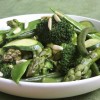Calcium is the dominant cation in all soils of agronomic importance. This 3-page document will explain the function of Calcium in turfgrasses, describe situations where applications would or would not be of value in turfgrass management, and identify calcium sources. Written by T. W. Shaddox and published by the UF/IFAS Environmental Horticulture Department, March 2018.
http://edis.ifas.ufl.edu/ep554
Tag: Calcium
Prevent Osteoporosis: Catch the Silent Thief
Osteoporosis means porous bones, or bones that have so many openings (pores) that they can easily break or be crushed. In the United States, 54 million people either have osteoporosis (10 million) or are at high risk (44 million) because they have low bone mass. By 2020, one in two Americans over the age of 50 is expected to have osteoporosis of the hip or be at high risk of developing the condition. This 11-page fact sheet discusses risk factors, calcium for bone building, calcium-rich foods, calcium supplements, vitamin D, and exercise. Written by Linda B. Bobroff, and published by the UF Department of Family, Youth and Community Sciences, revised February 2017.
http://edis.ifas.ufl.edu/fy469
Healthy Eating: Calcium / Alimentación Saludable: Calcio
 Calcium is the major mineral found in your bones and teeth. Many older adults don’t get enough calcium from the foods they eat. This can lead to bone loss and the bone disease osteoporosis. Osteoporosis puts people at high risk for bone fractures. These 1-page, large print fact sheets were written by Linda B. Bobroff, and published by the UF Department of Family Youth and Community Sciences, June 2013.
Calcium is the major mineral found in your bones and teeth. Many older adults don’t get enough calcium from the foods they eat. This can lead to bone loss and the bone disease osteoporosis. Osteoporosis puts people at high risk for bone fractures. These 1-page, large print fact sheets were written by Linda B. Bobroff, and published by the UF Department of Family Youth and Community Sciences, June 2013.
English: http://edis.ifas.ufl.edu/fy057
Spanish: http://edis.ifas.ufl.edu/fy058
Prevent Osteoporosis: Catch the Silent Thief (FCS8145/fy469)
 About 50 percent of women and 25 percent of men over age 50 will have a bone fracture caused by osteoporosis in their lifetimes. Many of these fractures, especially in the spine and hip, cause pain, disability, and loss of independence. About 24 percent of people aged 50 and over who have a hip fracture die in the year following the fracture. Learn more in this 8-page fact sheet written by Linda B. Bobroff and published by the UF Department of Family Youth and Community Sciences, March 2012.
About 50 percent of women and 25 percent of men over age 50 will have a bone fracture caused by osteoporosis in their lifetimes. Many of these fractures, especially in the spine and hip, cause pain, disability, and loss of independence. About 24 percent of people aged 50 and over who have a hip fracture die in the year following the fracture. Learn more in this 8-page fact sheet written by Linda B. Bobroff and published by the UF Department of Family Youth and Community Sciences, March 2012.
http://edis.ifas.ufl.edu/fy469
FCS8561Span/FY058 Alimentación Saludable: Calcio
FCS8561Span, a 1-page illustrated handout by Linda B. Bobroff, is the Spanish language version of FCS8561/FY057 Healthy Eating: Calcium. It uses a question-and-answer format to provide key information for elders about why calcium is important, what foods contain it, good sources of calcium, and how much older adults need. Published by the UF Department of Family Youth and Consumer Sciences, June 2010.
http://edis.ifas.ufl.edu/fy058
FCS8561/FY057 Healthy Eating: Calcium (1 page)
Revised! FCS-8561, a 1-page illustrated handout by Linda B. Bobroff, uses a question-and-answer format to provide key information for elders about why calcium is important, what foods contain it, good sources of calcium, and how much older adults need. Published by the UF Department of Family Youth and Consumer Sciences, March 2010.
http://edis.ifas.ufl.edu/fy057
FCS8568/FY068 Healthy Eating: Calcium
Revised! FCS8568, a 2-page illustrated handout by Linda B. Bobroff, uses a question-and-answer format to provide key information for elders about what calcium is, what foods contain it, what happens when people do not get enough, and how much older adults need. Includes references. Published by the UF Department of Family Youth and Consumer Sciences, March 2010.
http://edis.ifas.ufl.edu/fy068
FCS8703/FY216 Facts about Calcium
Revised! FCS-8703, a 3-page fact sheet by Linda B. Bobroff, answers common questions about calcium. Includes links to additional information. Published by the UF Department of Family Youth and Community Sciences, December 2008.
http://edis.ifas.ufl.edu/FY216

